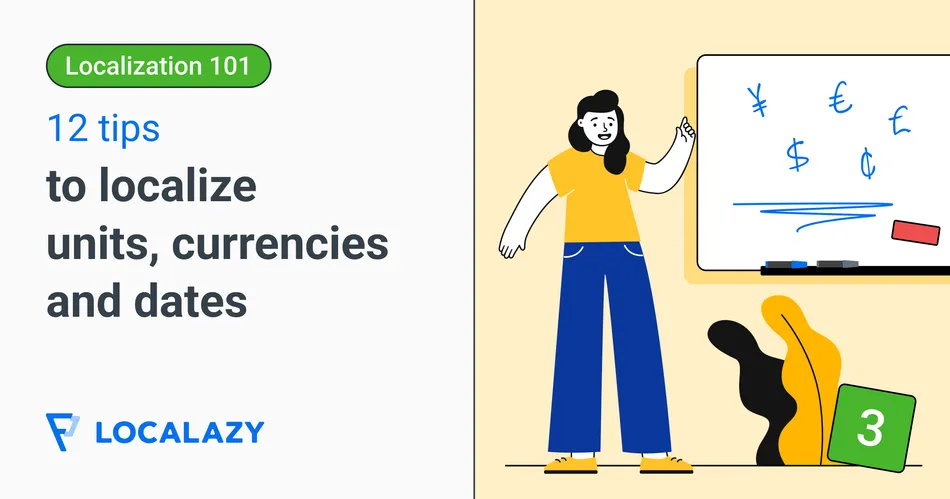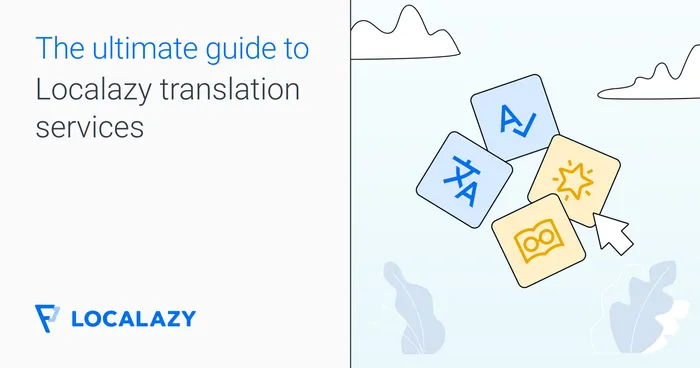We have now arrived at the localization of dates, units of measurement, and currencies. This is the third article in the Localization 101 series. Just as mentioned in the previous pieces, what feels familiar also feels reliable to customers. That includes pricing on a website and capitalizing months correctly in booking forms, which is exactly what we’ll cover today.
Customers recognize when a date isn’t properly formatted, and it will bother them. In global markets, details like how you display prices, write dates, or measure distances can be a deal breaker. Software localization is, particularly, one of the areas where this disrupts user experience the most. This article will walk you through how to get currencies, dates, and measurement units right for every market, so your users never pause, hesitate, or leave your app because they're having a subpar experience. But first, let's clear a couple of essential concepts.

👨💻 What is software localization? 🔗
Different countries, different rules. Imagine that you want to take your fashion app overseas and you choose Italy as your first expansion target. The Mediterranean country is known for its love for fashion, their focus on family, and their passion for food. They take their sweet time because that's how they savor every moment of life. 😌 So to enter the Italian market, you need to speak to the heart of the people and go beyond merely translating your products.
This is what software localization is about: your app or your website speaking to the locals in their tone, and adapting everything, from currency formatting to number formatting, to suit their customs. This includes text and design. You also have to ask yourself questions like, “Do Italians want to see pricing in large numbers, or should they be more subtle? And where on the page do you show the price for a suit or a dress?"
In other words, you will equip your software with the tools to do its job overseas and engage with the specific audience you're targeting.
🔖 Related read: How to choose the right languages to prioritize when expanding globally
What’s the difference between software localization and software translation? 🔗
There is a difference between just translating your software and actually localizing it. Translation is great if you have a website and need people to be able to read general information (e.g. a hotel website). Many companies do, in fact, start with software translation first and, as they expand globally, they implement localization. Others don’t have to.

Adapting your brand's messaging to a new country and culture has its benefits, though. Software translation helps customers understand your content, but localization directs them to feel, desire, and spend more.
🧮 Number localization tips 🔗
Now that we know what the differences are on paper, let's see what you can do to make sure your UX is as smooth for your international users than for your original customers.
Commas and decimals 🔗
A comma in California isn’t always a comma in Stockholm. Or it is, but it might belong somewhere else in a text. Using commas and decimals in localization might seem insignificant at first, but remember: it always comes back to familiarity. The same is true for languages where bidirectionality is present, like Arabic and Hebrew, which require specific formatting.
We suggest you get started with this:
- Know the differences between (most of) Europe, the United States, and the Middle East. Most countries in Europe use decimals when separating numbers, while the U.S. uses commas. In the Middle East, you have to remember that many countries have BiDi languages that mix RTL and LTR conventions, so formatting for UX designs, website forms, and even text looks quite different.
- Mind your commas and periods. Different languages, or even locales, use commas and periods differently when writing out numbers. For example, in Sweden, there are no periods or commas but instead, they use spaces. So 200,000 written in a New York blog post would be 200 000 without a comma if it was published in Sweden.
- Think both in data and text. Your goal should be to transform raw data into a readable format for a person from a specific country or region.
Localizing date formats 🔗
Date format localization is important for several reasons, including proper app user experience and simplifying functions, such as booking appointments with customers overseas. Making sure that your software has the code to create the correct regional date format is crucial to avoid customer frustration.
Here are a few tips to make this easier:
- 🗓 Use the standard format. The standard format for dates is called ISO 8601, which is frequently used in most industries and works in many countries. This is especially useful when you need precision, such as working with APIs and scheduling. The format has a basic version: YYYYMMDD, and an extended version: YYYY-MM-DD.
- Slash, dash, or period? As a guideline, most European countries use DD/MM/YYYY, for example: 11/12/2024 (11 December, 2024). On the other hand, countries like Japan and China use the standard ISO 8601 format, which would read: 2024/12/11. In a lot of technical localization, the slash (/) is replaced with a dash (–). Like this: 2024-12-11. Traveling to Germany, the German locals want to see the dates this way instead: 11.12.2024.
- Capitalize months and weekdays correctly. In the United States, people are used to seeing the 12 months of the year starting with a capital letter, like this: December. But in France or Sweden, for example, you would write December with a small d, unless you’re beginning a sentence. The same goes for weekdays.

Currency localization 🔗
Currency localization is important for global businesses, but also for companies expanding to a set of chosen areas. Without it, many customers abandon shopping carts, or leave the online store or site altogether.
So here are three tips for currency formatting:
- Show the correct price to your customers. If a customer in the United States shops on a Canadian website, the last thing you want is for the customer to be negatively surprised at checkout, or once they’ve paid. In this case, you have to make sure to use pricing in Canadian dollars instead of the American dollar from the get-go.
- Choose the right currency symbols. Currency symbols might look the same around the world, but they’re not always shown the same way or have the same position depending on the country. In the United States, a sweater costs $49.00 but in Sweden, the unconverted price is written as 49,00 $ (there is both a space and a shift in position). Needless to say that formatting for different currencies also varies. For instance, that same sweater in British pounds would be £35, and Swedish crowns would be formatted as 400 kr or, most commonly, 400:-.
- Differentiate between comma and decimal points. Another thing to consider in the example above is that one price has a decimal point, and the other has a comma. It’s important to get this right so that you’re not accidentally misleading customers.
Measurement units 🔗
We’ll end with measurement localization. Since not all countries use the same measurement units, it’s another aspect often included in localization.
In order to adapt well, you should:
- Know the unit systems: imperial or metric? Tell a Greek how many feet tall you are and they’ll probably look at you confused. Now, tell someone in Los Angeles how many kg you weigh and you’ll most likely get the same reaction. Metric units are used in most European countries and come from the word “metre”. Under its umbrella lies “milligram”, “litre” and “kilos”, among others. Imperial units, on the other hand, include measurements such as “gallon”, “inch”, and “yard”. The United States, Liberia, and Myanmar are currently the only countries that don’t use the metric system, and the United Kingdom uses both.
- Convert correctly between the systems. If your website in France is about to launch in the United States, you will need to change the measurement units to fit the new audience. Avoid literal conversions and keep standard measurements for the target country in mind.
- Collaborate with an expert in the area. If you’re not familiar with the localization of metric systems, it will be useful to have someone who works in the field well to help you with setting up a style guide, implementing the code, and proofreading before launch. You can also automate the majority of the process but have a tech linguist help you out with minor details and edits.

✔️ Conclusion 🔗
Number formatting might sound like a minor detail in your next international launch, but it's one of the elements that separates a natural user experience from a buggy, culturally misaligned one. When your user browses your app and doesn't bat a eye because they understand the dimensions of a product, they'll feel respected and understood. This removes friction, making your brand dependable.
No matter how big or small your business is, and what industry you're in (or are about to enter), our software localization features like Duplicate Linking make your number localization much easier so you can go through QA faster and strengthen your reputation in less time, with less effort.
📚 Other articles in the series 🔗
New to the localization world? Check out our other Localization 101 guides:




